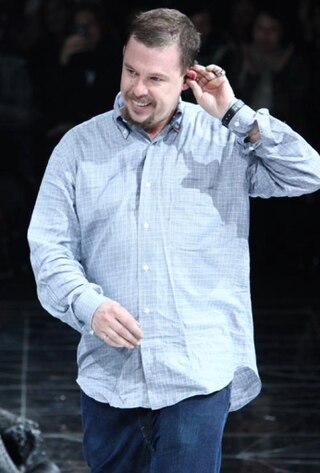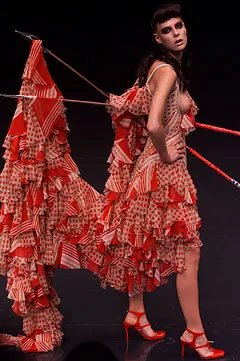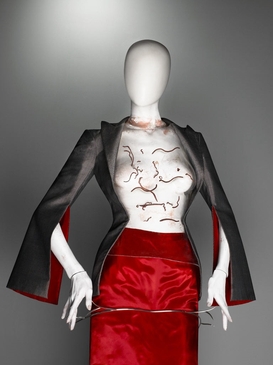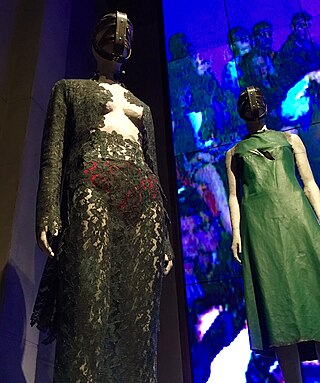
Lee Alexander McQueen was a British fashion designer and couturier. He founded his own Alexander McQueen label in 1992, and was chief designer at Givenchy from 1996 to 2001. His achievements in fashion earned him four British Designer of the Year awards, as well as the Council of Fashion Designers of America International Designer of the Year award in 2003. McQueen died by suicide in 2010 at the age of 40, at his home in Mayfair, London, shortly after the death of his mother.

Low-rise is a style of clothing designed to sit low on, or below, the hips. The style can also be called lowcut, hipster, or hip-hugger, and can apply to garments worn by all genders. The term can be applied to all garments that cover the wearer's crotch area, including trousers, jeans, shorts, skirts, panties, briefs, bikinis, pantyhose, and tights.

The Widows of Culloden is the twenty-eighth collection by British fashion designer Alexander McQueen, made for the Autumn/Winter 2006 season of his eponymous fashion house. It was inspired by his Scottish ancestry and is regarded as one of his most autobiographical collections. It is named for the women widowed by the Battle of Culloden (1746), often seen as a major conflict between Scotland and England. Widows makes extensive use of the McQueen family tartan and traditional gamekeeper's tweeds, as well as other elements taken from Highland dress. Historical elements reflected the fashion of the late Victorian era and the 1950s.

The Dance of the Twisted Bull is the nineteenth collection by British designer Alexander McQueen for his eponymous fashion house. Twisted Bull was inspired by Spanish culture and art, especially the traditional clothing worn for flamenco dancing and bullfighting. In McQueen's typical fashion, the collection included sharp tailoring and historicist elements and emphasised femininity and sexuality.

The Birds is the fifth collection by British designer Alexander McQueen for his eponymous fashion house. The Birds was inspired by ornithology, the study of birds, and the 1963 Alfred Hitchcock film The Birds, after which it was named. Typically for McQueen in the early stages of his career, the collection centred on sharply tailored garments and emphasised female sexuality. McQueen had no financial backing, so the collection was created on a minimal budget.

Neptune is the twenty-seventh collection by British designer Alexander McQueen for his eponymous fashion house. It took inspiration from classical Greek clothing, 1980s fashion, and the work of artists influential in that decade. The runway show was staged during Paris Fashion Week on 7 October 2005 at the industrial warehouse of the Imprimerie Nationale. Two main phases were presented, with 56 looks total: the first phase comprised monochrome black clothing, while the second featured a white, green, and gold palette. The collection's clothing and runway show both lacked McQueen's signature theatricality, and critical reception at launch and in retrospect was negative. Items from Neptune appeared in the 2022 exhibition Lee Alexander McQueen: Mind, Mythos, Muse.

Irere was the twenty-first collection by British fashion designer Alexander McQueen for his eponymous fashion house. Irere was inspired by imagery from the Age of Discovery and from the people and animals of the Amazon rainforest. Its title is claimed to mean 'transformation' in an unspecified Indigenous Amazonian language. The collection comprised three distinct concepts presented as a narrative sequence: shipwrecked pirates, menacing conquistadors, and tropical birds. McQueen described the collection as an effort to present a more mature point of view and surprise viewers with bold colours.

The oyster dress is a high fashion gown created by British fashion designer Alexander McQueen for his Spring/Summer 2003 collection Irere. McQueen's design is a one-shouldered dress in bias-cut beige silk chiffon with a boned upper body and a full-length skirt consisting of hundreds of individual circles of organza sewn in dense layers to the base fabric, resembling the outside of an oyster shell. According to McQueen, the gown took a month's work for three people, who cut and assembled all the pieces individually. In addition to the original beige dress, a version with a red bodice and the ruffled skirt in rainbow colours was also created. The beige and red versions appeared in the Irere runway show, and were photographed for magazines to promote the collection.

Jack the Ripper Stalks His Victims is the first collection by British designer Alexander McQueen, produced as the thesis collection for his master's degree in fashion at Central Saint Martins (CSM) art school. The collection's narrative was inspired by the victims of 19th-century London serial killer Jack the Ripper, with aesthetic inspiration from the fashion, erotica, and prostitution practices of the Victorian era. The collection was presented on the runway at London Fashion Week on 16 March 1992, as the second-to-last of the CSM graduate collections. Editor Isabella Blow was fascinated by the runway show and insisted on purchasing the entire collection, later becoming McQueen's friend and muse.

The Hunger is the seventh collection by British designer Alexander McQueen for his eponymous fashion house. The collection was primarily inspired by The Hunger, a 1983 erotic horror film about vampires. McQueen had limited financial backing, so the collection was created on a minimal budget. Typically for McQueen in the early stages of his career, the collection centred around sharply tailored garments and emphasised female sexuality. It was his first collection to include menswear.

Highland Rape is the sixth collection by British designer Alexander McQueen for his eponymous fashion house. Like many of McQueen's early collections, this collection featured untraditional women's tailoring heightening the models' figures and sexuality. Although very poorly received critically and publicly, the Highland Rape is one of McQueen's most famous shows that solidified his name in the fashion world. The runway show was presented on 13 March 1995 during London Fashion Week as his 1995 Autumn/Winter collection. The collection was dark and nationalistic, most notably epitomising the McQueen house's use of Scottish tartan and the bumster trouser, designed to show as much of the torso as possible without showing all of the crotch or bum.

The Overlook was the fourteenth collection by British fashion designer Alexander McQueen for his eponymous fashion house. It was inspired by the Stanley Kubrick horror film The Shining (1980) and named for the fictional Overlook Hotel where much of the film takes place. The collection focused on winter clothing in light and neutral colours, including chunky knitwear, fur and shearling coats, and parkas inspired by Inuit clothing. Showpiece items included a bustier made from rock crystal and a corset made from coils of aluminium, the latter provided by jeweller and frequent McQueen collaborator Shaun Leane.

Pantheon ad Lucem is the twenty-fourth collection by British designer Alexander McQueen for his eponymous fashion house. Inspired by ideas of rebirth, ancient Greek garments and science fiction films including 2001: A Space Odyssey (1968) and Star Wars (1977), the collection focused on sleek draped, wrapped, or tied jersey designs in light and neutral colours, with some evening wear in darker colours. Contrasting the slimline items were heavier garments including tweed suits and fur coats. McQueen expressed his fascination with altering the silhouette, emphasising the hips to a degree that was uncommon for him.

The Girl Who Lived in the Tree is the thirty-second collection by British fashion designer Alexander McQueen, made for the Autumn/Winter 2008 season of his eponymous fashion house. The primary inspirations were British culture and national symbols, particularly the British monarchy, as well as the clothing of India during the British Raj. The collection was presented through the narrative of a fairy tale about a feral girl who lived in a tree before falling in love with a prince and descending to become a princess.

Joan was the twelfth collection by British fashion designer Alexander McQueen for his eponymous fashion house. Continuing McQueen's dual fascination with religion and violence, it was inspired by imagery of persecution, most significantly the 1431 martyrdom of French Catholic saint Joan of Arc, who was burned at the stake. The collection's palette was mainly red, black, and silver; colours which evoked notions of warfare, death, blood, and flames. Many looks referenced ecclesiastical garments and medieval armour, including several items that mimicked chainmail and one ensemble that had actual silver-plated armour pieces.

Nihilism is the third collection by British designer Alexander McQueen for his eponymous fashion house. McQueen developed the collection following the launch of his own label with Taxi Driver, which was exhibited in March 1993 at the Ritz Hotel in London in lieu of a fashion show. An eclectic collection with no straightforward theme, Nihilism pushed back against dominant womenswear trends with its hard tailoring, and aggressive, sexualised styling. It was created in collaboration with McQueen's associates Simon Ungless and Fleet Bigwood. Like Taxi Driver, Nihilism included experimental techniques, silhouettes, and materials, such as dresses made from cellophane, stained with clay, or adorned with dead locusts.

Voss is the seventeenth collection by British fashion designer Alexander McQueen, made for the Spring/Summer 2001 season of his eponymous fashion house. The collection drew on imagery of madness and the natural world to explore ideas of bodily perfection, interrogating who and what was beautiful. Like many of McQueen's collections, Voss also served as a critique of the fashion industry, which McQueen was often ambivalent about. Voss featured a large number of showpiece designs, including dresses made with razor clam shells, an antique Japanese screen, taxidermy hawks, and microscope slides. The collection's palette mainly comprised muted tones; common design flourishes included Orientalist and surrealist elements.

The Horn of Plenty: Everything But the Kitchen Sink is the thirty-fourth collection by British fashion designer Alexander McQueen, made for the Autumn/Winter 2009 season of his eponymous fashion house. The collection drew on household rubbish and the aesthetics of classic haute couture fashion to satirise the fashion industry for its wastefulness and lack of originality. The Horn of Plenty also featured reimagined designs and reworked items from previous collections, serving as a retrospective of McQueen's own design history. Common design flourishes included houndstooth patterns, design elements overdone to ironic proportions, and prints based on the natural world. Production was shadowed by photographer Nick Waplington, who published a photo book documenting the collection's creation in 2013.

What a Merry-Go-Round is the eighteenth collection by British fashion designer Alexander McQueen, made for the Autumn/Winter 2001 season of his eponymous fashion house. The collection drew on imagery of clowns and carnivals, inspired by McQueen's feelings about childhood and his experiences in the fashion industry. The designs were influenced by military chic, cinema such as Nosferatu (1922) and Cabaret (1972), 1920s flapper fashion, and the French Revolution. The palette comprised dark colours complemented with neutrals and muted greens. The show marked the first appearance of the skull motif that became a signature of the brand.



















